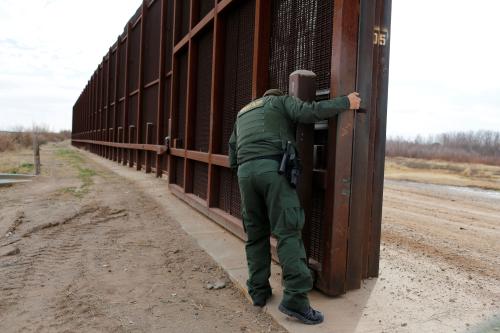Building a wall on the Mexican border was a signature issue in Donald Trump’s campaign in 2016. The wall has both failed to garner public support and was rebuffed by Congress in the omnibus spending bill passed by the House in May. Despite candidate Trump’s refrain that he would get Mexico to pay for it, that plan evaporated long before the inauguration. Although some administration officials have tried to manage expectations, the president has stuck to his campaign promise and even proposed new features—recently mentioning solar panels at a rally in Iowa.
In a new paper released by the Center for Effective Public Management, “Hitting the wall: On immigration, campaign promises clash with policy realities,” John Hudak, Elaine Kamarck and Christine Stenglein find that the Trump administration’s goals with regard to immigration are out of reach, starting with the border wall.
The paper points to several major impediments to making President Trump’s campaign promise to build a border wall a reality:
- We do not know if the high cost of a wall is worth it because DHS has never conducted a cost-benefit analysis comparing physical barriers to other modes of fighting illegal immigration.
- Building a wall is a major public works project and we may not have the construction workers needed.
- A virtual wall called SBINet was tried and failed in the George W. Bush and Barack Obama Administrations.
- The project will require the purchase of private lands, and the use of eminent domain when landowners refuse. Land grabs by the government are especially controversial among Trump’s Republican base.
Specifically, with reference to the border wall, some important questions must be answered: What are the infrastructure needs at the border, and how have massive efforts to change it fared in the past?
More than 600 miles of the border have some form of fencing, either to block pedestrians in urban areas or vehicles in more remote regions. This fencing was mainly built in the 10 years since George W. Bush signed the Secure Fences Act of 2006. There are also zones of the border with fencing three layers deep, to slow border crossers so they can be apprehended before reaching populated areas where it’s easier to evade Border Patrol officers. The purpose of fencing has been to deter and slow down unauthorized immigration. Although its effectiveness has not been measured, the truth is that for all practical purposes, the southern border already has a barrier in place.
George W. Bush was the last president to attempt a major border infrastructure project, ironically to help facilitate immigration reform. Reform opponents in Congress insisted on improving border security before considering the president’s immigration agenda. SBINet, so named as part of the Southern Border Initiative, was a plan to install high-tech infrastructure along all U.S. borders that would detect illegal activity and report it immediately to Border Patrol. This “virtual wall” was plagued by contracting problems and operating glitches, and was eventually scrapped—but not before over $1 billion in federal funds were spent.
In the years since, Customs and Border Patrol has been using technology extensively. Cameras, blimps, drones, ground sensors and other systems feed information to agents in the field. What continues to prove valuable for immigration enforcement is information: for agents to make decisions about border crossers at ports of entry, and for CBP to know where illegal activity is taking place between ports of entry. Physical barriers are an important complement to this, but a wall can’t solve all problems at the border. The challenges that exist along the border are not uniform and vary dramatically depending on the place, terrain, and proximity to populated areas.
The situation at the southern border is complex; the idea of a wall seems like it came from another country.
The Brookings Institution is committed to quality, independence, and impact.
We are supported by a diverse array of funders. In line with our values and policies, each Brookings publication represents the sole views of its author(s).







Commentary
Hitting the wall: Challenges to President Trump’s signature campaign promise
June 23, 2017